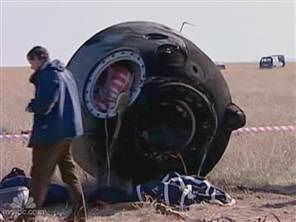The Progress 46 cargo ship successfully docked to the International Space Station’s Pirs Docking Compartment late on January 27 to deliver almost three tons of food, fuel and supplies for the six crew members living and working on the orbital laboratory. The Russian cargo launched on January 26 from the Baikonur Cosmodrome in Kazakhstan.
Test Failure Points to Potential Delay for Next Soyuz Launch
[/caption]
Russia may have to delay the launch of the next crew to the International Space Station, as the descent module of the Soyuz spacecraft experienced an air leak during testing. The next crew of three for the space station had been scheduled to launch on March 30, 2012. Russia’s news agency Itar-Tass quoted Russian space agency (Roscosmos) official Alexei Krasnov, saying the Soyuz TMA–04M experienced problems during a test in an altitude test chamber at the Energia Space Rocket Corporation. Krasnov said no final decisions have been made yet on whether a delay will be necessary, but other sources indicated it could be delayed for several weeks.
Krasnov downplayed the seriousness of the failure, indicating the problems are related to a service element, rather than the descent capsule itself.
But earlier reports sounded more dire. “This descent vehicle can no longer be used in a manned flight,” said an unnamed source in an article in RIA Novosti. “Therefore the launch of the Soyuz TMA-04M will have to be rescheduled until the second half of April or the first half of May.”
The three ISS crewmembers scheduled to launch for Expedition 31 are Russians Gennady Padakla and Sergei Rivin and NASA astronaut Joseph Acaba, who will be replacing Expedition 30 crewmates Anton Shkaplerov, Anatoli Ivanishin and Dan Burbank, who arrived at the station in November, 2011.
The three Expedition 30 crew were initially scheduled to return to Earth on March 16, but since their own launch was delayed, their Soyuz craft does have some margin before exceeding its on-orbit certified life, and depending on the outcome of the inspection of the TMA–04M, they would be able to stay a few weeks longer.
The potential delay follows a series of technical mishaps for Roscomos during the past few months. In August of 2011 a Progress re-supply ship crashed back to Earth after the second stage of the rocket failed to ignite. In November, the Phobos-Grunt mission to Mars moon Phobos also experienced rocket failure and it ultimately disintegrated during re-entry to Earth’s atmosphere. In December, a Soyuz-2 rocket carrying a communications satellite failed shortly after launch from the Plesetsk spaceport.
Orion Capsule Embarks on Cross Country Public Tour
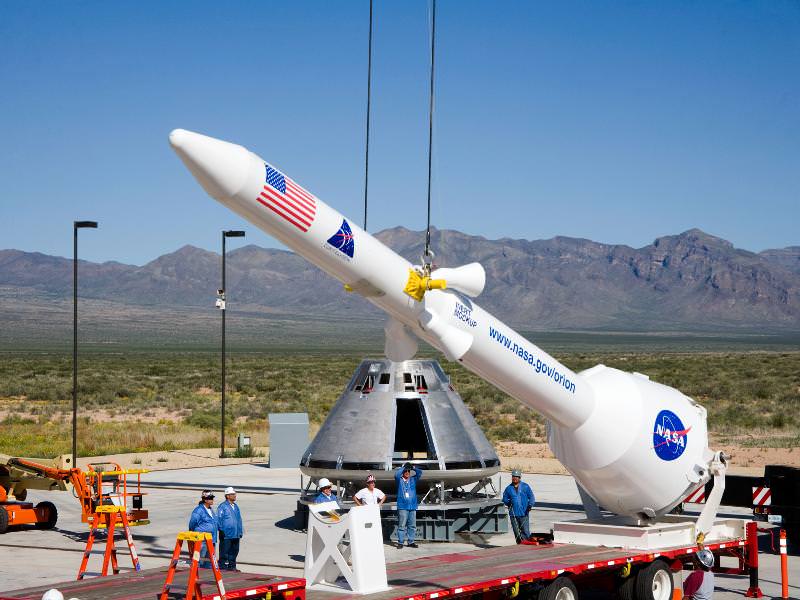
[/caption]
Here’s your chance for a birds-eye view of an Orion capsule, up-close and personal ! Catch it if you can !
A full scale test version of one of NASA’s Orion spacecraft has embarked on a cross country tour from White Sands, New Mexico, across several states in the southern United States that ultimately lands at the Kennedy Space Center in Florida.
Starting today, Jan. 27, an Orion spacecraft is open for viewing by the public in Texas at Victory Park and the American Airlines Center in Dallas.

The Coopers from Southlake meet NASA astronaut Nick Patrick by the Orion crew module now on display at the American Airlines Center in Dallas, TX.
The display continues throughout this weekend after a well received visit to Oklahoma at the Science Museum Oklahoma in Oklahoma City.
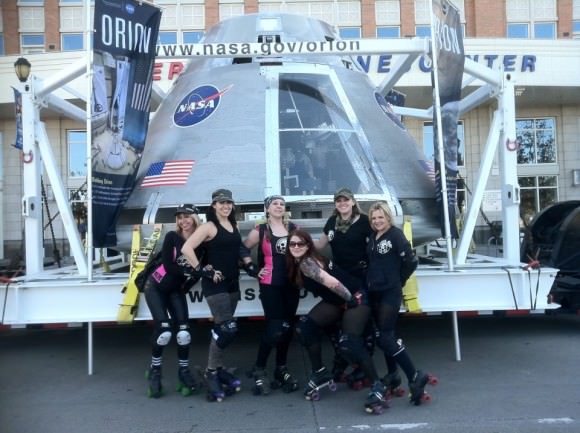
The next stop on the cross country journey is the U.S. Space and Rocket Center in Huntsville, Ala on Feb 1-2.
Orion is NASA’s next generation human spaceflight vehicle that will eventually replace the space shuttle and loft astronauts to low Earth orbit and beyond to deep space destinations such as the Moon, Asteroids and Mars. It can also dock at the International Space Station (ISS).
The Orion crew module journey is a wonderful and fun opportunity for individuals and families to see real space exploration hardware with your own eyes and learn all about the goals and plans of the US Space Program and your investment in it as a taxpayer.
Knowledgeable Orion experts will be on hand to speak with visitors in easy to understand ways. This includes astronauts, engineers, program officials and press spokespeople from NASA, Lockheed-Martin (Orion prime contractor) and other companies involved in building the Orion capsule and other components that will rocket the vehicle to orbit.
Veteran NASA Astronauts Nick Patrick and Clay Anderson will be on hand at the Dallas stop. NASA Astronauts Doug Hurley and Jim Dutton will attend the Alabama display.
Hurley was the pilot for the final shuttle mission by Space Shuttle Atlantis for the STS-135 mission to the International Space Station.
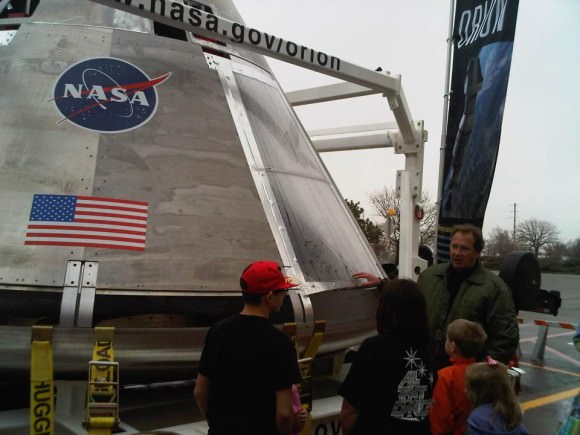
The Orion tour also includes colorful and informative display panels and fun kids activities that I’ve personally witnessed on several occasions. In past years the Orion Launch Abort System (LAS) engaged in similar trips.
This Orion test vehicle was used by ground crews preparing for the PA-1 launch abort system flight test that took place in New Mexico in 2010.
The first orbital flight test of an unmanned Orion is scheduled for 2014 atop a Delta 4 Heavy booster..
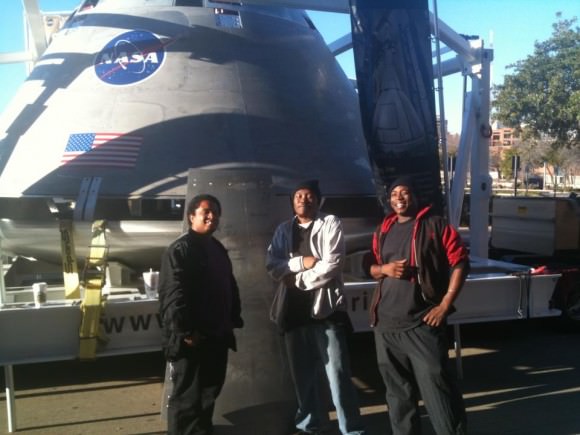
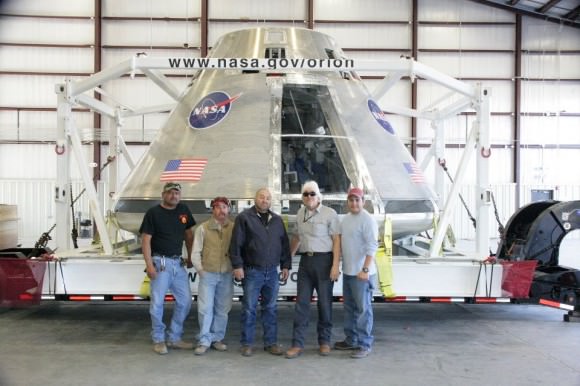
Look here for more information on the Orion stops in Texas and Alabama
American Airlines Center: http://www.americanairlinescenter.com/
U.S. Space and Rocket Center: http://www.ussrc.com/
NASA’s future has suddenly become a hot topic in the GOP Presidential Debates. Orion is at the center of that debate on whether Americans will ever return to the Moon.
This is your opportunity to see history in the making
Does Water Ice Lurk Beneath the Poles of Vesta ?

[/caption]
The mysterious asteroid Vesta may well have more surprises in store. Despite past observations that Vesta would be nearly bone dry, newly published research indicates that about half of the giant asteroid is sufficiently cold and dark enough that water ice could theoretically exist below the battered surface.
Scientists working at NASA’s Goddard Space Flight Center in Greenbelt, Md., and the University of Maryland have derived the first models of Vesta’s average global temperatures and illumination by the Sun based on data obtained from the Hubble Space Telescope.
“Near the north and south poles, the conditions appear to be favorable for water ice to exist beneath the surface,” says Timothy Stubbs of NASA’s Goddard Space Flight Center in Greenbelt, Md., and the University of Maryland, Baltimore County. The research by Timothy Stubbs and Yongli Wang, of the Goddard Planetary Heliophysics Institute at the University of Maryland, was published in the January 2012 issue of the journal Icarus.
If any water lurks beneath Vesta, it would most likely exist at least 10 feet (3 meters) below the North and South poles because the models predict that the poles are the coldest regions on the giant asteroid and the equatorial regions are too warm.

This global map of average surface temperature shows the warmer equatorial zone of the giant asteroid Vesta is likely too warm to sustain water ice below the surface. But roughly half of Vesta is so cold and receives so little sunlight on average that water ice could have survived there for billions of years. The dividing lines (solid gray) are found at about 27 degrees north latitude and 27 degrees south latitude. This map, with temperatures given in kelvins, comes from the first published models of the average global temperature and illumination conditions on Vesta. Credit: NASA/GSFC/UMBC
If proven, the existence of water ice at Vesta would have vast implications for the formation and evolution of the tiny body and upend current theories.
The surface of Vesta is not cold enough for ice to survive all the time because unlike the Moon, it probably does not have any significant permanently shadowed craters where water ice could stay frozen on the surface indefinitely.
Even the huge 300 mile diameter (480-kilometer) crater at the South Pole is not a good candidate for water ice because Vesta is tilted 27 degrees on its axis, a bit more than Earth’s tilt of 23 degrees.
By contrast, the Moon is only tilted 1.5 degrees and possesses many permanently shadowed craters. NASA’s LCROSS impact mission proved that water ice exists inside permanently shadowed lunar craters.
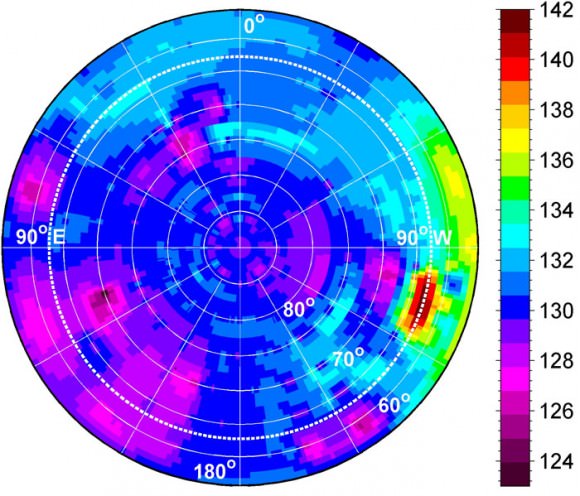
The models predict that the average annual temperature around Vesta’s poles is below minus 200 degrees Fahrenheit (145 kelvins). Water ice is not stable above that temperature in the top 10 feet of Vestan soil, or regolith.
At the equator and in a band stretching to about 27 degrees north and south in latitude, the average annual temperature is about minus 190 degrees Fahrenheit (145 kelvins), which is too high for the ice to survive.
“On average, it’s colder at Vesta’s poles than near its equator, so in that sense, they are good places to sustain water ice,” says Stubbs in a NASA statement. “But they also see sunlight for long periods of time during the summer seasons, which isn’t so good for sustaining ice. So if water ice exists in those regions, it may be buried beneath a relatively deep layer of dry regolith.”
Vesta is the second most massive asteroid in the main Asteroid belt between Mars and Jupiter.
NASA’s Dawn Asteroid Orbiter is the very first mission to Vesta and achieved orbit in July 2011 for a 1 year long mission.
Dawn is currently circling Vesta at its lowest planned orbit. The three science instruments are snapping pictures and the spectrometers are collecting data on the elemental and mineralogical composition of Vesta.
The onboard GRaND spectrometer in particular could shed light on the question of whether water ice exists at Vesta.
So far no water has been detected, but the best data is yet to come.
In July 2012, Dawn fires up its ion thrusters and spirals out of orbit to begin the journey to Ceres, the largest asteroid of them all.
Ceres is believed to harbor huge caches of water, either as ice or in the form of oceans and is a potential habitat for life.
NASA’s Resilient Rover Opportunity Begins Year 9 On Mars with Audacious Science Ahead
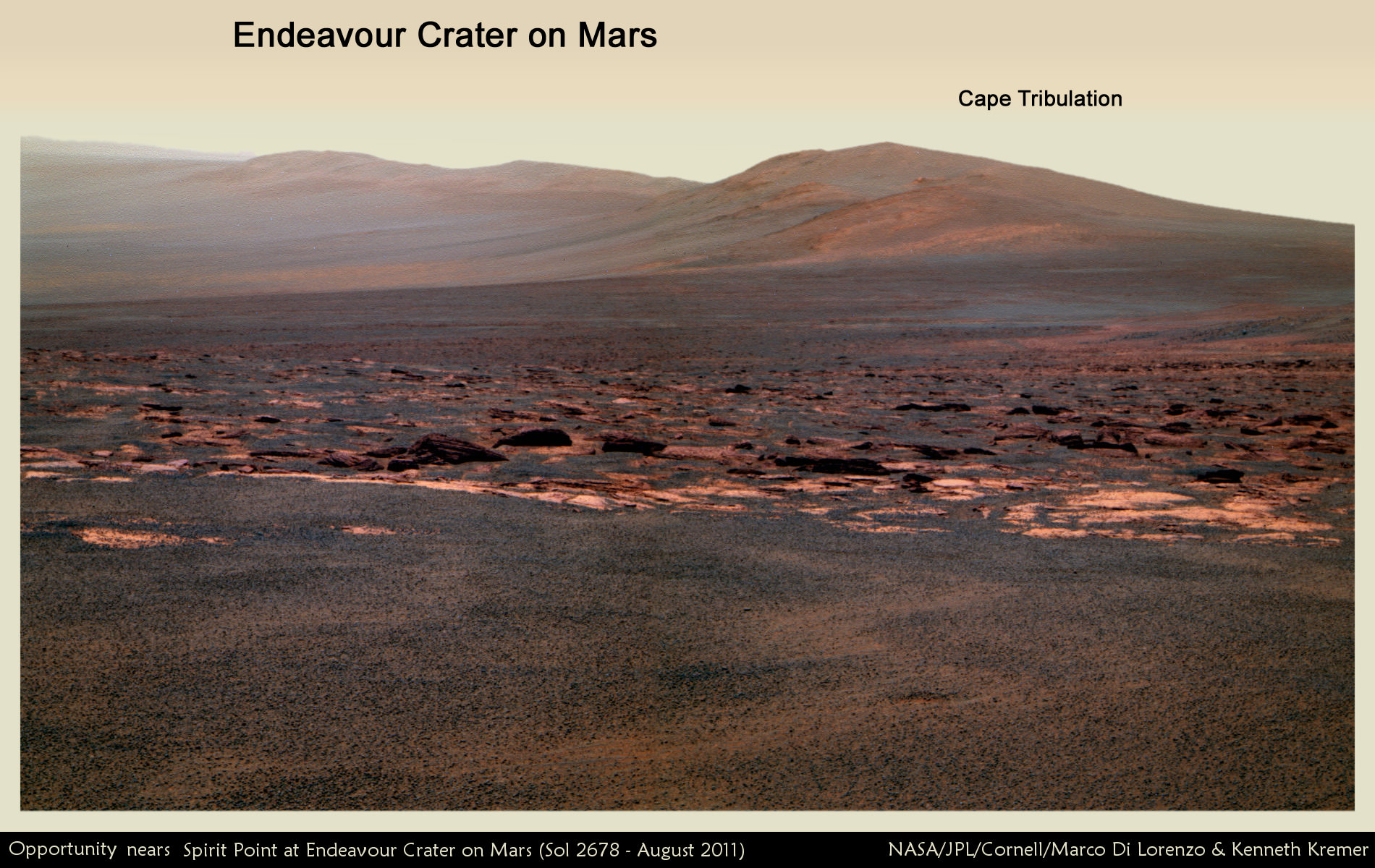
[/caption]
Today, the resilient Opportunity robot begins her 9th year roving around beautifully Earth-like Martian terrain where potentially life sustaining liquid water once flowed billions of years ago.
Opportunity celebrates her 8th anniversary on the Red Planet gazing at the foothills of the vast crater named Endeavour, promising a “mother lode” of “watery” science – an unimaginable circumstance since the nail biting landing on the hematite rich plains of Meridiani Planum on 24 January 2004.
“Opportunity is 97 months into the 3 month mission,” team members are proud and universally surprised to say.
“Milestones like 8 years on Mars always make me look forward rather than looking back,” Rover Principal Investigator Prof. Steve Squyres of Cornell University told Universe Today for this article commemorating Opportunity’s landing.
“We’ve still got a lot of exploring to do, but we’re doing it with a vehicle that was designed for a 90-sol mission. That means that every sol is a gift at this point.”
Opportunity has driven more than 21 miles (34 kilometers) across the Red Planet’s surface during what is truly humankind’s first overland expedition on another Planet. See our route map below.
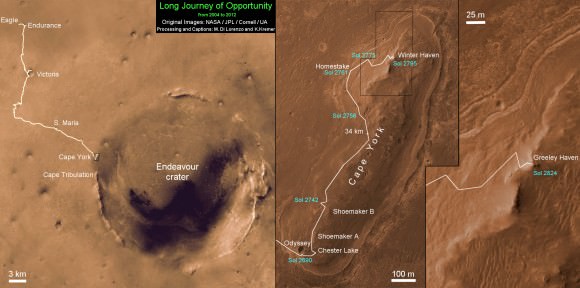
Traverse map shows the 8 Year Journey of Opportunity from Eagle Crater landing site on Sol 1- Jan. 24, 2004 - to 5th Winter Haven worksite at Greeley Haven at Endeavour Crater rim in January 2012. Opportunity embarked on a crater tour and discovered bountiful evidence for the flow of liquid water on Mars billions of years ago. The robot has shown that ancient ephemeral shallow lakes existed on Mars when the cratered terrain was cut by fluvial channels. Endeavour Crater is 14 miles (22 kilometers) in diameter. Opportunity has so far driven more than 21 miles (34 km) over 8 Years but was only expected to live for 90 Martian days. Credit: NASA/JPL/Cornell/UA/Marco Di Lorenzo/Kenneth Kremer
NASA’s twin rovers Spirit and Opportunity blasted off for Mars atop a pair of Delta II rockets in the summer of 2003 with a mission “warranty” of just 90 Martian days, or Sols.
Today is Sol 2846 of working operations for Opportunity, compared to an anticipated lifetime of only 90 Sols – that amounts to more than 31 times beyond the designer’s expectations.
Indeed, the long lived robot is now enduring her 5th Winter on Mars. And to glimpse the next Martian sunrise, the robo girls manmade components must survive the harsh extremes of frigid Antarctic-like temperatures each and every sol.
“I never thought that we would still be planning sequences for Opportunity today,” Ray Arvidson told Universe Today. Arvidson, of Washington University in St. Louis, is the deputy rover principal investigator.
“I seriously thought both Spirit and Opportunity would be finished by the summer of 2004.”
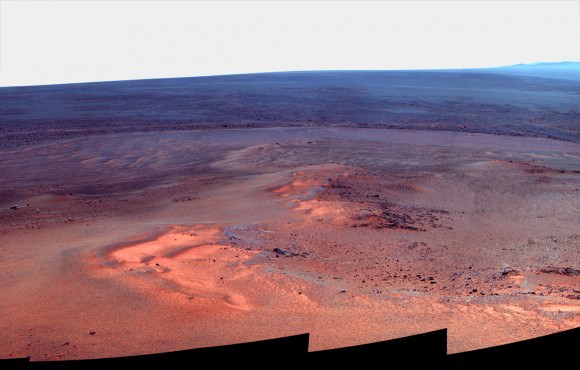
But, Opportunity is the gift to science that keeps on giving.
“I am feeling pretty good as the MER rover anniversaries approach,” Arvidson told me.
“Opportunity has shown that ancient ephemeral shallow lakes existed as Mars moved climatically from an early period when the cratered terrain was cut by fluvial channels to the current dry and cold conditions that dominate.”
“Both rovers have conclusively shown the need for lateral mobility to get to relevant outcrops and back out the secrets associated with past conditions,” Arvidson explained.
Barely a month ago the bountiful harvest from mobility was once again demonstrated when the science team lead by Squyres and Arvidson announced that Opportunity had discovered the most scientifically compelling evidence yet for the flow of liquid water on ancient Mars.
Squyres and Arvidson announced that Opportunity had found a bright vein – named “Homestake” – composed of the mineral gypsum located at the Cape York segment of Endeavour Crater where the intrepid robot is currently spending her 5th Martian Winter.
“This gypsum vein is the single most powerful piece of evidence for liquid water at Mars that has been discovered by the Opportunity rover,” Squyres explained.
Veins are a geologic indication of the past flow of liquid water.
See our mosaic below illustrating the exact location of the “Homestake” vein at Endeavour Crater – also published at Astronomy Picture of the Day; 12 Dec 2011.
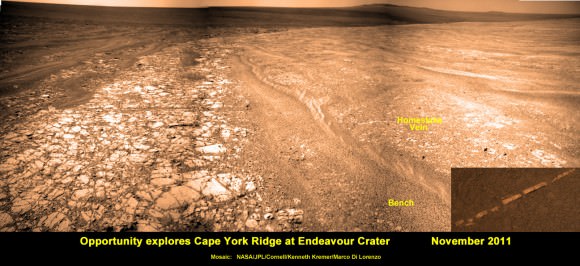
Opportunity rover discovered Gypsum at the Homestake mineral vein, while exploring around the base of Cape York ridge at the rim of Endeavour Crater. The vein is composed of calcium sulfate and indicates the ancient flow of liquid water at this spot on Mars. This panoramic mosaic of images was taken on Sol 2761, November 2011, and illustrates the exact spot of the mineral vein discovery.
Credit: NASA/JPL/Cornell/Kenneth Kremer/Marco Di Lorenzo
Published on Astronomy Picture of the Day (APOD): 12 Dec 2011
Opportunity just arrived at the rim of the 14 mile (22 kilometer) wide Endeavour Crater in mid-August 2011 following an epic three year trek across treacherous dune fields from her prior investigative target at the ½ mile wide Victoria Crater.
“It’s like a whole new mission since we arrived at Cape York,” says Squyres.
For the next few months of the bitterly cold Martian winter, Opportunity will conduct a vigorous science campaign while remaining mostly stationary at a spot dubbed “Greeley Haven” in honor of Prof. Ronald Greeley, a team member from Arizona State University who recently passed away.

This mosaic shows the view of NASA’s Opportunity rover parked at “Greeley Haven” worksite where the robot will spend her 5th Martian Winter. This mosaic of images shows the Winter Haven view from the Cape York Ridge at the western rim of Endeavour Crater looking south along the crater rim. Tire tracks at right. Credit: NASA/JPL/Cornell/ Marco Di Lorenzo/Kenneth Kremer
At this moment Opportunity is snapping a 360 degree panorama, deploying her robotic arm onto nearby outcrops, collecting microscopic images, making measurements of mineral compositions with the Alpha Particle X-Ray Spectrometer and conducting radio science observations to elucidate the unknown structure of the Martian interior and core.
The rover is covered with a significant coating of dust which limits her ability to generate power from the life sustaining solar arrays. Since Opportunity is traversing just south of the equator, engineers have temporarily parked her on a northerly facing slope to maximize the electric power generation.
“Opportunity is currently sitting on an outcrop of impact breccias at Greeley Haven on Cape York,” said Arvidson.
Opportunity will remain at Greeley Haven until some time after the Winter Solstice of southern Martian winter occurs at the end of March.
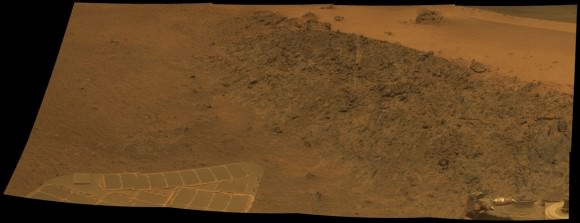
Then she’ll head south to further explore the veins and eventually drive to deposits of the clay mineral located a few miles (km) away along the craters rim.
“We’ll do good science while we’re at Greeley Haven. But as soon as we catch a wind gust or the seasons change, we’ll be on our way again,” Squyres told me.
The legendary twins Spirit and Opportunity surely rank as one of the greatest triumphs in space exploration.
New Progress Re-Supply Ship Launches to Space Station
With a ‘textbook’ launch, the Progress 46 resupply ship is now on its way to the International Space Station. The Progress launched Wednesday at 11:06 UTC (6:06 p.m. EST, 5:06 a.m. Baikonur time Thursday) from the Baikonur Cosmodrome, Kazakhstan. Inside the vehicle are 2.9 tons of food, fuel and equipment. It will arrive at the ISS and hook up via automated docking with the Pirs docking compartment on 00:08 UTC on Saturday (Friday at 7:08 p.m. EST)
Continue reading “New Progress Re-Supply Ship Launches to Space Station”
Opportunity arrives at Greeley Haven – 5th Winter Haven Worksite on Mars
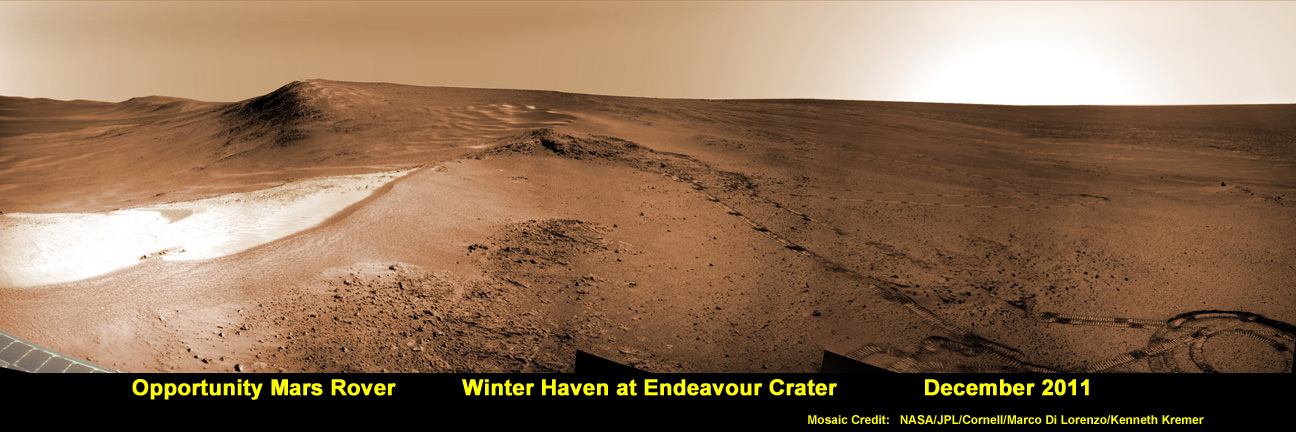
[/caption]
NASA’s seemingly indestructible Opportunity rover has arrived at the breathtaking location where she’ll be working through her unfathomable 5th Martian Winter. The Opportunity Mars Exploration Rover has not only endured, but flourished for 8 years of unending “Exploration & Discovery” on the Red Planet despite having an expected lifetime at landing of just 3 months, way back in January 2004.
Opportunity is parked at a northward facing outcrop dubbed “Greeley Haven” where she can soak up the sun and juice her innards throughout the utterly harsh and Antarctic-like temperatures on tap for the next few months that threaten to kill her each and every Martian day. See our mosaic above around the Greeley Haven area.
Science team members told Universe Today that the rover is sitting at Greeley Haven because the site offers a roughly 15 degree tilt that will maximize the electric output from the life-giving solar arrays and also allow the robot to carry out a vigorous science campaign during the seasonal Martian winter season that officially begins in March.
Greeley Haven is a located at the northern tip of the “Cape York” segment of the western rim of the vast crater named Endeavour, some 14 miles (22 km) wide that’s loaded with a bountiful variety of rocks and soil that neither Opportunity nor her twin Spirit have ever touched and drilled into before and stem from an earlier epoch when liquid water flowed eons ago and perhaps may have been more favorable to sustaining life.
“Opportunity is currently sitting on Saddleback at Greeley Haven, an outcrop of impact breccias on Cape York, Endeavour crater’s rim,” Ray Arvidson told Universe Today. Arvisdon is the mission’s deputy principal investigator, of Washington University in St. Louis.
“Her northerly tilt is about ~15 degrees which is enough to have a vibrant winter campaign. The Martian southern winter solstice occurs at the end of March. A few months after that date we will drive her off the outcrop and further explore Cape York.”
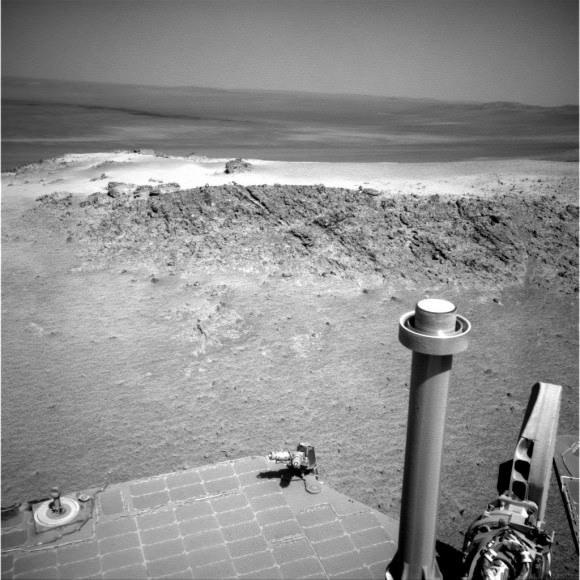
Opportunity captured this view of a northward-facing outcrop, "Greeley Haven," where the rover will work during its fifth Martian winter. This southward-looking image was taken on Sol 2790 on Mars (Nov. 29, 2011). The rover team chose this designation as a tribute to the influential planetary geologist Ronald Greeley (1939-2011), who was a member of the science team for the Mars rovers and many other interplanetary missions. Credit: NASA/JPL-Caltech
“Greeley Haven” is named in tribute to planetary Geologist Ronald Greeley (1939-2011) who was a beloved member of the rover science team and a host of other NASA planetary missions. He taught at Arizona State University and inspired several generations of students and planetary scientists until his recent death on Oct. 27, 2011.
“We’ll hunker down at Greeley Haven as long as we need to, and we’ll do good science while we’re there,” Steve Squyres of Cornell University, Ithaca, N.Y., told Universe Today. Squyres is the Principal Investigator for Opportunity.
Opportunity is collecting a high resolution 360 degree panorama to commemorate Greeley.
Throughout the past 4 Martian winters, Opportunity had continued to traverse without pause. But this winter time it’s different because the solar panels are significantly more coated with an obscuring layer of dust hindering their energy output.
So the rover is parked with a tilt for her 5th Martian winter, mimicking the successful strategy power boosting used by Spirit to survive 3 harsh Martian winters.
And there is a silver lining to sitting mostly still that enables a chance to determine what’s at the core of the Red Planet, a key fact we don’t know.
“This winter science campaign will feature two way radio tracking with Earth to determine the Martian spin axis dynamics – thus the interior structure, a long-neglected aspect of Mars,” Arvidson told me.
I asked Squyres for a progress update and how long would the data collection require ?
Squyres replied that the experiment has already begun and added – “Hard to say how long. It’s months, as opposed to weeks or years, but it depends very much on data quality and the amount of data we get per week. We’re very early in the experiment now… we’ll just see how it goes.”
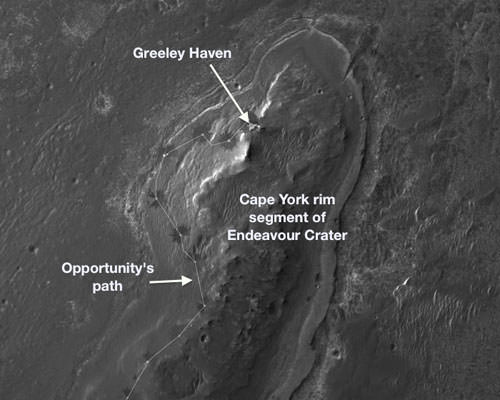
Opportunity will spend its fifth Martian winter working at Greeley Haven on the western rim of Endeavour Crater. Credit: NASA/JPL-Caltech/UA
Gabby Giffords To Resign From Congress
U.S. Congresswoman Rep. Gabrielle Giffords (D) announced today, Sunday Jan. 22, that she will step down from Congress later this week to continue recuperating from critical brain injuries she suffered during a deadly assassination attempt a year ago in Tucson, Arizona.
She announced the resignation on her official congressional website and in a poignant YouTube video message (see above) to her constituents saying that she will “do what is best for Arizona” as she recovers from the shooting attack that happened 1 year ago on Jan. 8, 2011 in her Arizona district.
One of her last official acts will be to attend the State of the Union Address by President Obama on Tuesday, January 24 at the Capitol in Washington, D.C.
Giffords is submitting letters of resignations to House Speaker John Boehner and Arizona Gov. Jan Brewer. Brewer will call a special primary and general election to fill her seat for the remainder of her term which expires at the end of 2012. The primary election will be held within about 60 days. She represented the 8th Congressional District in southern Arizona.
“Gabby Giffords embodies the very best of what public service should be. She’s universally admired for qualities that transcend party or ideology – a dedication to fairness, a willingness to listen to different ideas, and a tireless commitment to the work of perfecting our union. That’s why the people of Arizona chose Gabby – to speak and fight and stand up for them,” President Obama said in a statement issued Sunday evening. “Gabby’s cheerful presence will be missed in Washington. But she will remain an inspiration to all whose lives she touched – myself included. And I’m confident that we haven’t seen the last of this extraordinary American.”
“I salute Congresswoman Giffords for her service, and for the courage and perseverance she has shown in the face of tragedy. She will be missed,” House Speaker John Boehner said in a statement issued Sunday.
Before the shooting she was considered to be a rising star in Congress.
Giffords was shot in the head at point blank range. Six people were killed including a 9 year old girl and a Federal Judge and 13 others were wounded.
The 41 year old congresswoman is resigning in order to continue her recovery from the gunshot wounds she suffered a year ago while conducting a ‘meet-and-greet’ with her constituents at a shopping center in Tucson. She has been undergoing intensive rehabilitation over the past year.

“I have more work to do on my recovery, so to do what is best for Arizona, I will step down this week,” Congresswoman Giffords says in the heartfelt two minute video message to her constituents.
“A lot has happened over the past year,” she said in halting words. “We cannot change that. But I know on the issues we fought for, we can change things for the better. Jobs, border security, veterans. We can do so much more by working together.”
The video features footage of Giffords before and after the attack, some of it quite graphic.
“I don’t remember much from that horrible day, but I will never forget the trust you placed in me to be your voice,” Giffords goes on to say. “Thank you for your prayers and for giving me time to recover. I have more work to do on my recovery. So to do what is best for Arizona, I will step down this week.”
Giffords was first elected to the U.S. House of Representatives in November 2006. She was last re-elected in November 2010 and now will not seek re-election this fall.
Gabby Giffords was a strong supporter of NASA and America’s space program.
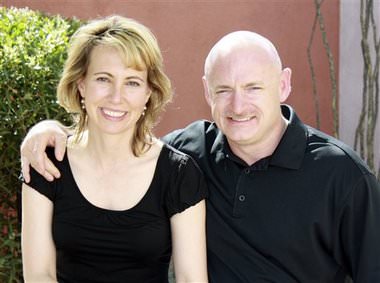
She is married to veteran Astronaut Mark Kelly, who commanded the last mission of Space Shuttle Endeavour in May 2011, STS-134. Kelly recently resigned from NASA to continue helping Gabby in her recovery.
The shooting happened as Kelly was in the final stages of training for the STS-134 mission. Kelly temporarily interrupted his training to be with his wife who was in critical condition.
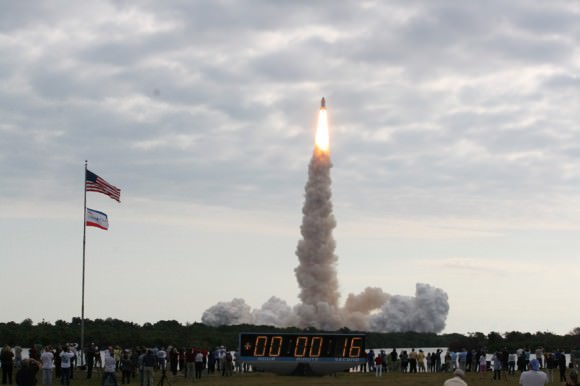
Gabby Giffords has made a remarkable recovery and she continues to improve and inspire all of us every day. She faces a long road of recovery ahead that will require all her efforts to continue making progress.
“Every day my spirit is high. I will return. Thank you !” – Giffords signs off
3 Generations of NASA’s Mars Rovers

[/caption]
NASA Mars rovers have come a long way in terms of size and capability since the rebirth of Red Planet surface exploration just 15 years ago – spanning from 1997 to 2012.
To get a really excellent sense of just how far America’s scientists and engineers have pushed the state of the art in such a short time – when the willpower and funding existed and coincided to explore another world – take a good look at the new pictures here showing 3 generations of NASA’s Mars rovers; namely Mars Pathfinder (MPF), the 1st generation Mars rover, Mars Exploration Rover (MER), the 2nd generation, and Mars Science Laboratory (MSL), the 3rd and newest generation Mars rover.
The newly released pictures graphically display a side by side comparison of the flight spare for Mars Pathfinder (1997 landing) and full scale test rovers of the Mars Exploration Rover (2004 landing) and Mars Science Laboratory (in transit for a 2012 planned landing). The setting is inside the “Mars Yard” at NASA’s Jet Propulsion Laboratory, Pasadena, Calif. where the teams conduct mission simulations.
It’s been nothing less than a quantum leap in advancement of the scientific and technological capability from one generation to the next.
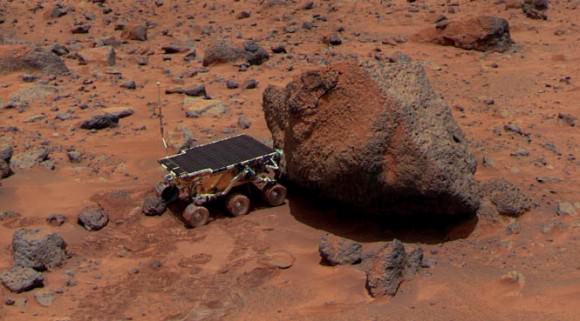
Sojourner takes an Alpha Proton X-ray Spectrometer (APXS) measurement of Yogi rock after Red Planet landing on July 4, 1997 landing. Sojourner was only 2 feet long, the size of a microwave oven.
Credit: NASA
Just consider the big increase in size – growing from a microwave oven to a car !
The “Marie Curie” flight spare and the actual “Sojourner” rover on Mars are 2 feet (65 centimeters) long – about the size of a microwave oven. The MER rovers “Spirit and Opportunity” and the “Surface System Test Bed” rover are 5.2 feet (1.6 meters) long – about the size of a golf cart. The MSL “Curiosity” and the “Vehicle System Test Bed” rover are 10 feet (3 meters) long – about the size of a car.
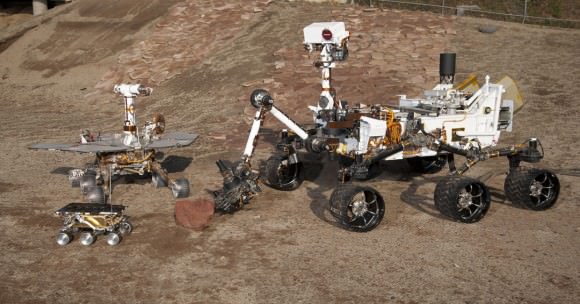
Front; flight spare for the first Mars rover, Sojourner. Left; Mars Exploration Rover Project test rover. Right; Mars Science Laboratory test rover Credit: NASA/JPL-Caltech
With your own eyes you can see the rapid and huge generational change in Mars rovers if you have the opportunity to visit the Kennedy Space Center Visitor Complex and stroll by the Mars exhibit with full scale models of all three of NASA’s Red Planet rovers.
At the KSC Visitor Complex in Florida you can get within touching distance of the Martian Family of Rovers and the generational differences in size and complexity becomes personally obvious and impressive.
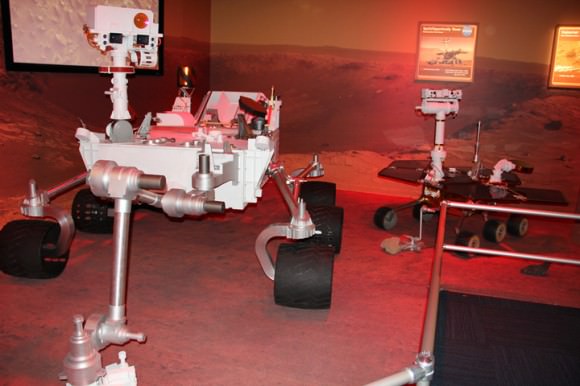
Full scale models on display at the Kennedy Space Center Visitor Complex. Curiosity and Spirit/Opportunity are pictured here. Sojourner out of view. Credit: Ken Kremer
All of the Mars rovers blasted off from launch pads on Cape Canaveral Air Force Station, Florida.
Sojourner, Spirit and Opportunity launched atop Delta II rockets at Space Launch Complex 17 in 1996 and 2003. Curiosity launched atop an Atlas V at Space Launch Complex 41 in 2011.
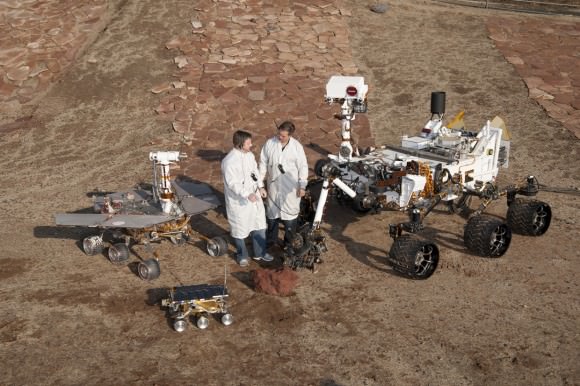
The rovers are pictured here with real Mars Engineers to get a sense of size and perspective. Front rover is the flight spare for the first Mars rover, Sojourner. At left is a Mars Exploration Rover Project test rover, working sibling to Spirit and Opportunity. At right is a Mars Science Laboratory test rover the size of Curiosity which is targeting a August 2012 Mars landing. The Mars engineers are JPL's Matt Robinson, left, and Wesley Kuykendall. Credit: NASA/JPL-Caltech
Opportunity is still exploring Mars to this day – 8 years after landing on the Red Planet, with a warranty of merely 90 Martian days.
Curiosity is scheduled to touch down inside Gale crater on 6 August 2012.
So, what comes next ? Will there be a 4th Generation Mars rover ?
Stay tuned – only time and budgets will tell.
Gallery: Cosmonaut Winter Survival Training

[/caption]
When cosmonauts and astronauts now return from a long-duration space mission on board the International Space Station, they are always coming home on a Soyuz capsule, landing in northern Kazakhstan. The Kazakh Steppe is known for its bitter winters (I just checked the local weather in Ayagoz, Kazakhstan and there is currently a blizzard going on with heavy snow, high winds and a current temperature of -26 C [-15 F] )
When a Soyuz lands, it usually takes at least an hour for the rescue team to arrive. But a blizzard or other unforeseen problems could leave the crew stranded for longer periods of time. So, cosmonauts and astronauts undergo special survival training, just in case. Here are some images from the latest crew to undergo the training, featuring cosmonaut Sergei Prokopyeva, ESA astronauts Thomas Pesquet and Samantha Cristoforetti. Remember that complicating any return from long-duration space flight is the weakness the space travelers will experience after six months in weightlessness.
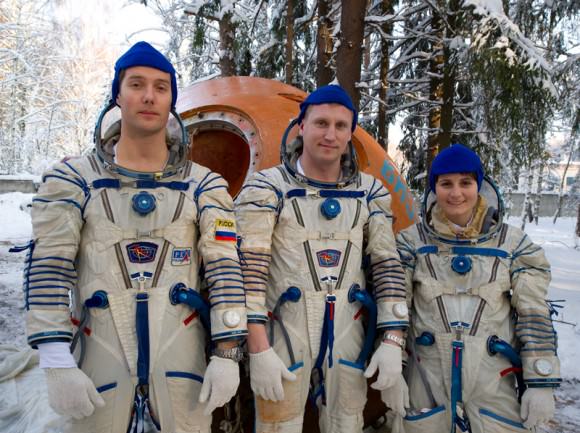
In addition to the technical knowledge related to the landing capsule, the cosmonauts/astronauts need to practice practical skills like constructing a shelter and building a fire. They have a special emergency kit in the Soyuz which includes weapons, lights, water (6 liters for three people), dried food, first aid kit, tools and equipment that may be useful in extreme conditions, and clothing such as a heat suit, woolen cap, headset, gloves, socks and fur socks.
The Cosmonaut Training Center website says that “to successfully complete the test (training), crews have to show courage, self-discipline, perseverance, and patience.”
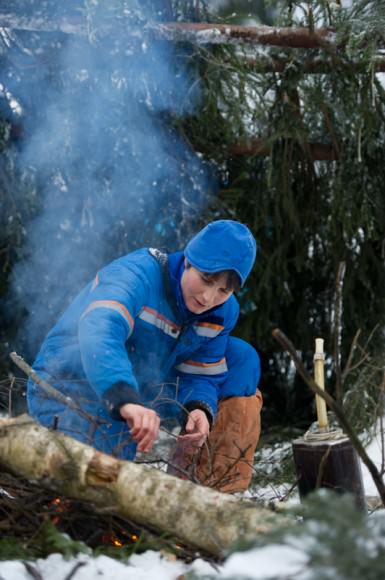
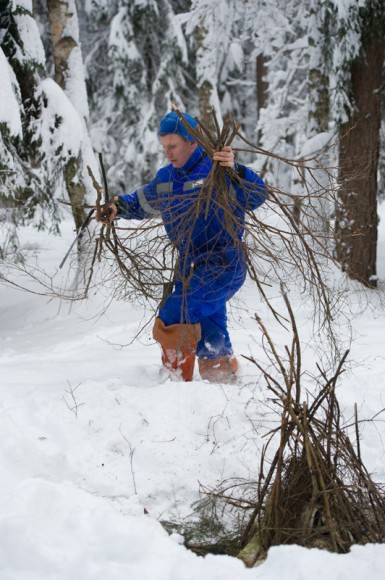
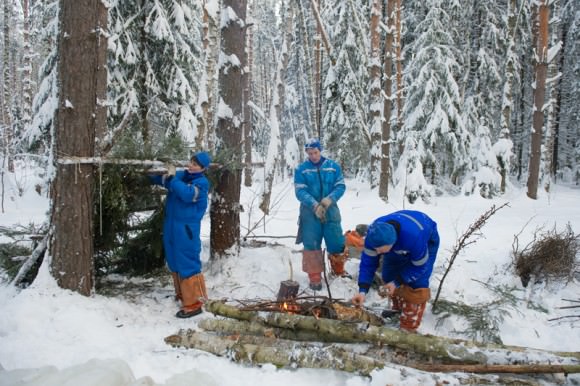
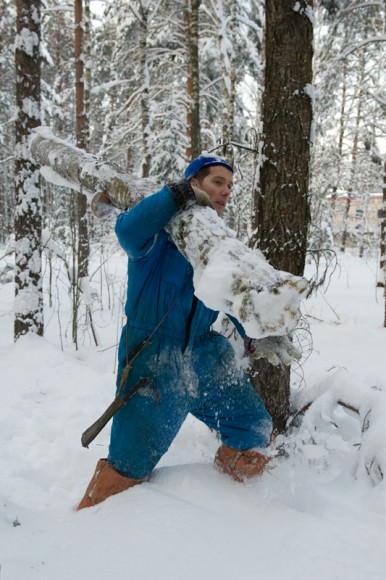
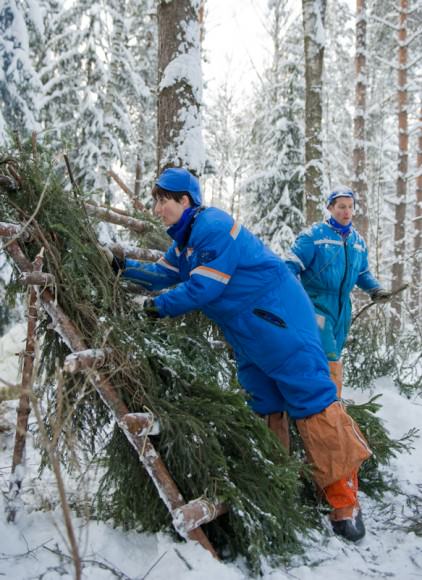
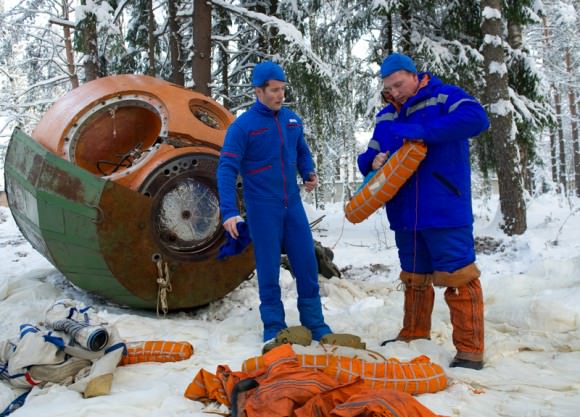
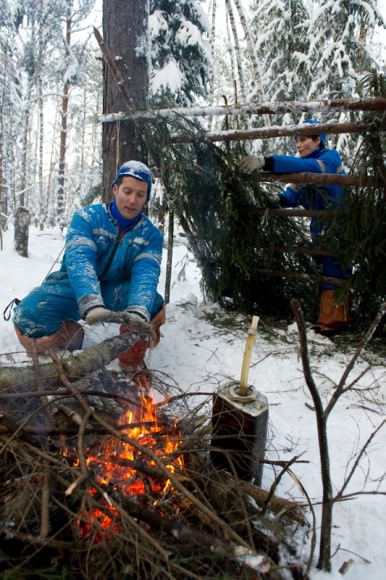
Don’t worry — Samantha Cristoforetti said on Google+ that the can near the fire is water, not gasoline!

